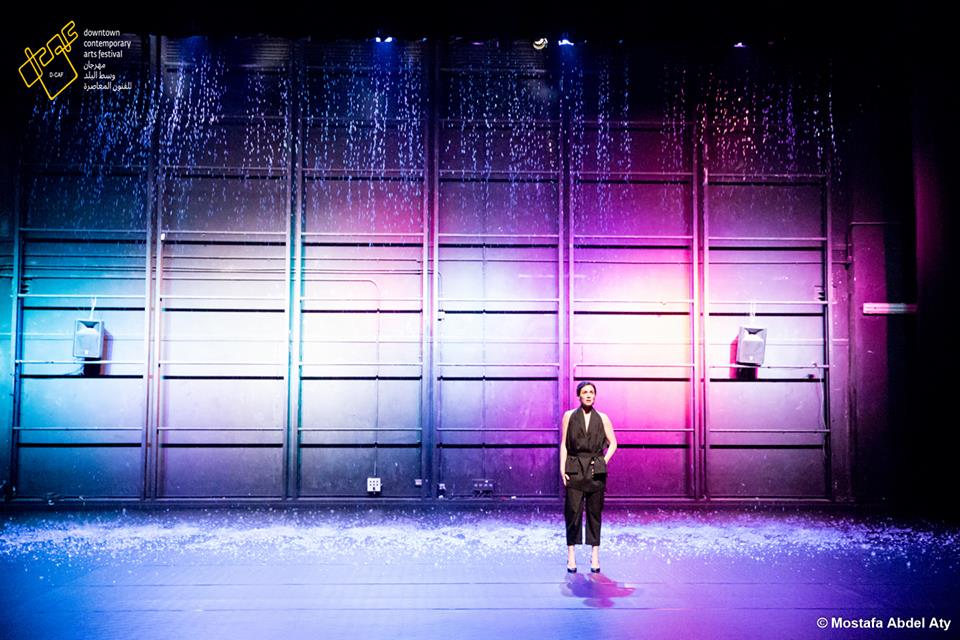French Monodrama Blurs Reality on AUC’s Falaki Stage
By Malak Nour
In collaboration with Egypt’s Institut Français, and as part of its seventh edition, the Downtown Contemporary Arts Festival (DCAF) premiered Clémentine Baert’s monodrama Alors, est-ce que c’est là? (So, is it here?) at AUC’s El Falaki Theatre on March 13.
Alors, est-ce que c’est là? first ran at the Festival Artdanthé in 2015, and was performed, written and conceptualized by French actress Clémentine Baert who worked with both film and theatre directors, like Pascal Rambert, Christophe Fiat, Emmanuel Mouret, and Wim Wenders.
The monodrama blurs the line between illusion and reality, as it tells the story of a woman who finds herself abandoned by the man she deeply loves, trying to piece back together the now-scattered parts of herself, and the equally scattered story of his disappearance.
Her lover’s identity and existence float like a shadow between the real and the imaginary, posing bigger questions about the reality of our very perceptions and our trust in them.
Baert’s performance beamed with the immense despair, loss, and sense of desolation felt by her character.
The protagonist’s troubled state of disbelief was accurately reflected through Baert’s facial expressions and a voice which displayed an array of conflicting emotions, ranging from monotony and false composure to sudden agonized shouts and even bursts of song.
The character’s monologue was characterized and dominated by a sense of reluctance that epitomized the character’s position as an unreliable narrator.
She stumbled over her sentences, rephrased them, and incessantly repeated some of her words for no apparent reason, reflecting a deeply troubled state of mind.
This unpredictability and instability of the character who happens to be the audience’s sole source of information led to the blurring of the line between illusion and reality that characterized the monodrama as a whole.
This atmosphere of uncertainty was further accentuated by Philippe Gladieu’s lighting and Alexandre Meyer’s music and sound, both of which subtly added a very powerful dimension to the character’s monologue, but without subduing it.
For example, the dark colour of the character’s costume blended in very well with the dimness of her surroundings, facilitating her disappearing into them as was the case at several segments of the monodrama.
In those segments, the lighting would die down, transforming the stage into a sea of near blackness, making Baert’s character barely visible to the audience even as she continued to speak.
She was then made completely invisible by the very last scene of the monodrama when the stage turned pitch black, evoking the image of the black holes she would mention throughout.
In this way, lighting played on the audience’s perception, adding to the piece’s overall air of perplexity.
The sense of sound was also toyed with, as, at some points, it was very easy to mistake the sounds of the monodrama with sounds from the audience’s actual surroundings, leaving the audience in a literal blur between reality and fiction.
For example, the subtle sounds at the beginning could have been very easily mistaken for actual backstage rumble.
This subtle yet potent play with light and sounds served to further the audience’s disorientation, both overloading and confusing their own sensory experiences.
Having been disoriented on a sensory level through light and sound, as well as on a cognitive level through the monologue’s unreliability, the audience got to experience a glimpse of the inner goings-on of the character for themselves.
Her unreliable memory, the talk about dreams and wormholes that suck people into the unknown, were no longer rendered unfamiliar.
Alors, est-ce que c’est là? is a monodrama that merges between the real and unreal subtly yet so effectively that you can’t help but wonder about your own reality…“so, is it here?”




